Control of motility patterns in the human colonic circular muscle layer by pacemaker activity
- PMID: 9625887
- PMCID: PMC2231034
- DOI: 10.1111/j.1469-7793.1998.309bz.x
Control of motility patterns in the human colonic circular muscle layer by pacemaker activity
Abstract
1. This study characterized the electrical and mechanical activities of human colonic muscle strips obtained from either the ascending, descending or sigmoid colon of patient volunteers during elective colon resections. 2. Rhythmic contractile activity was observed in colonic circular muscle strips in the absence of external stimuli. This activity persisted in the presence of atropine, phentolamine, propranolol, tetrodotoxin and Nomega-nitro-L-arginine but was abolished by nifedipine. 3. The activity of whole circular muscle (WCM) was compared with that of the myenteric half (MCM), the submucosal half (SCM) and the interior (ICM) of the circular muscle layer. WCM exhibited a prominent 2-4 contractions min-1 contractile pattern which was also present in strips of SCM. In contrast, MCM and ICM exhibited slow (0.3-0.6 contractions min-1), long duration contractions with superimposed higher frequency contractions (17-18 contractions min-1). 4. Resting membrane potential (Vm), recorded at various positions through the thickness of WCM strips did not differ and averaged -50 mV. 5. Slow waves were observed in 83 % of muscles. They averaged 12 mV in amplitude, 9.4 s in duration and had a frequency of 2-4 contractions min-1. Slow waves were greatest in amplitude near the submucosal edge and decreased with distance away from this edge. Each slow wave was associated with a transient contraction. 6. Near the myenteric edge, rapid fluctuations of Vm with a mean frequency of 18 contractions min-1 were recorded in 67 % of muscles. Spiking activity was common and was superimposed upon slow waves and rapid Vm fluctuations. 7. In summary, slow waves were identified in the human colonic circular muscle layer which arise at or near the submucosal edge. These electrical events give rise to a 2-4 contractions min-1 contractile rhythm which is characteristic of the intact muscle layer. Thus, the nature and spatial organization of pacemaker activity in the human colon bears significant resemblance to other animal models, such as the dog and pig.
Figures

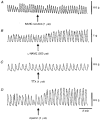
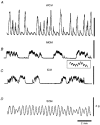

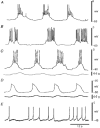

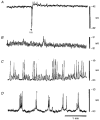
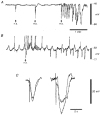
Similar articles
-
Postjunctional alpha 1- and beta-adrenoceptor effects of noradrenaline on electrical slow waves and phasic contractions of cat colon circular muscle.Br J Pharmacol. 1995 Dec;116(8):3265-73. doi: 10.1111/j.1476-5381.1995.tb15134.x. Br J Pharmacol. 1995. PMID: 8719806 Free PMC article.
-
Electrical activities of the muscle layers of the canine colon.J Physiol. 1983 Sep;342:67-83. doi: 10.1113/jphysiol.1983.sp014840. J Physiol. 1983. PMID: 6631753 Free PMC article.
-
Basal release of nitric oxide induces an oscillatory motor pattern in canine colon.J Physiol. 1997 Mar 15;499 ( Pt 3)(Pt 3):773-86. doi: 10.1113/jphysiol.1997.sp021968. J Physiol. 1997. PMID: 9130172 Free PMC article.
-
The search for the origin of rhythmicity in intestinal contraction; from tissue to single cells.Neurogastroenterol Motil. 2000 Feb;12(1):3-9. doi: 10.1046/j.1365-2982.2000.00177.x. Neurogastroenterol Motil. 2000. PMID: 10652111 Review.
-
Problems with extracellular recording of electrical activity in gastrointestinal muscle.Nat Rev Gastroenterol Hepatol. 2016 Dec;13(12):731-741. doi: 10.1038/nrgastro.2016.161. Epub 2016 Oct 19. Nat Rev Gastroenterol Hepatol. 2016. PMID: 27756919 Free PMC article. Review.
Cited by
-
Automated Analysis Using a Bayesian Functional Mixed-Effects Model With Gaussian Process Responses for Wavelet Spectra of Spatiotemporal Colonic Manometry Signals.Front Physiol. 2021 Feb 11;11:605066. doi: 10.3389/fphys.2020.605066. eCollection 2020. Front Physiol. 2021. PMID: 33643057 Free PMC article.
-
Effects of excitatory and inhibitory neurotransmission on motor patterns of human sigmoid colon in vitro.Br J Pharmacol. 2008 Dec;155(7):1043-55. doi: 10.1038/bjp.2008.332. Epub 2008 Sep 1. Br J Pharmacol. 2008. PMID: 18846038 Free PMC article.
-
Contribution of delayed rectifier potassium currents to the electrical activity of murine colonic smooth muscle.J Physiol. 1999 Mar 1;515 ( Pt 2)(Pt 2):475-87. doi: 10.1111/j.1469-7793.1999.475ac.x. J Physiol. 1999. PMID: 10050014 Free PMC article.
-
Insights into the mechanisms underlying colonic motor patterns.J Physiol. 2016 Aug 1;594(15):4099-116. doi: 10.1113/JP271919. Epub 2016 Jun 9. J Physiol. 2016. PMID: 26990133 Free PMC article. Review.
-
Understanding the physiology of human defaecation and disorders of continence and evacuation.Nat Rev Gastroenterol Hepatol. 2021 Nov;18(11):751-769. doi: 10.1038/s41575-021-00487-5. Epub 2021 Aug 9. Nat Rev Gastroenterol Hepatol. 2021. PMID: 34373626 Review.
References
-
- Burke EP, Gerthoffer WT, Sanders KM, Publicover NG. Wortmannin inhibits contraction without altering electrical activity in canine gastric smooth muscle. American Journal of Physiology. 1996;270:C1405–1412. - PubMed
-
- Berezin I, Huizinga JD, Daniel EE. Interstitial cells of Cajal in the canine colon: a special communication network at the inner border of the circular muscle. Journal of Comparative Neurology. 1988;273:42–51. - PubMed
-
- Du C, Conklin JL. Origin of slow waves in the isolated proximal colon of the cat. Journal of the Autonomic Nervous System. 1989;28:167–178. 10.1016/0165-1838(89)90089-1. - DOI - PubMed
-
- Faussone-Pellegrini MS, Pantalone D, Cortesini C. Smooth muscle cells, interstitial cells of Cajal and myenteric plexus interrelationships in the human colon. Acta Anatomica. 1990;139:31–44. - PubMed
Publication types
MeSH terms
Grants and funding
LinkOut - more resources
Full Text Sources
Miscellaneous

